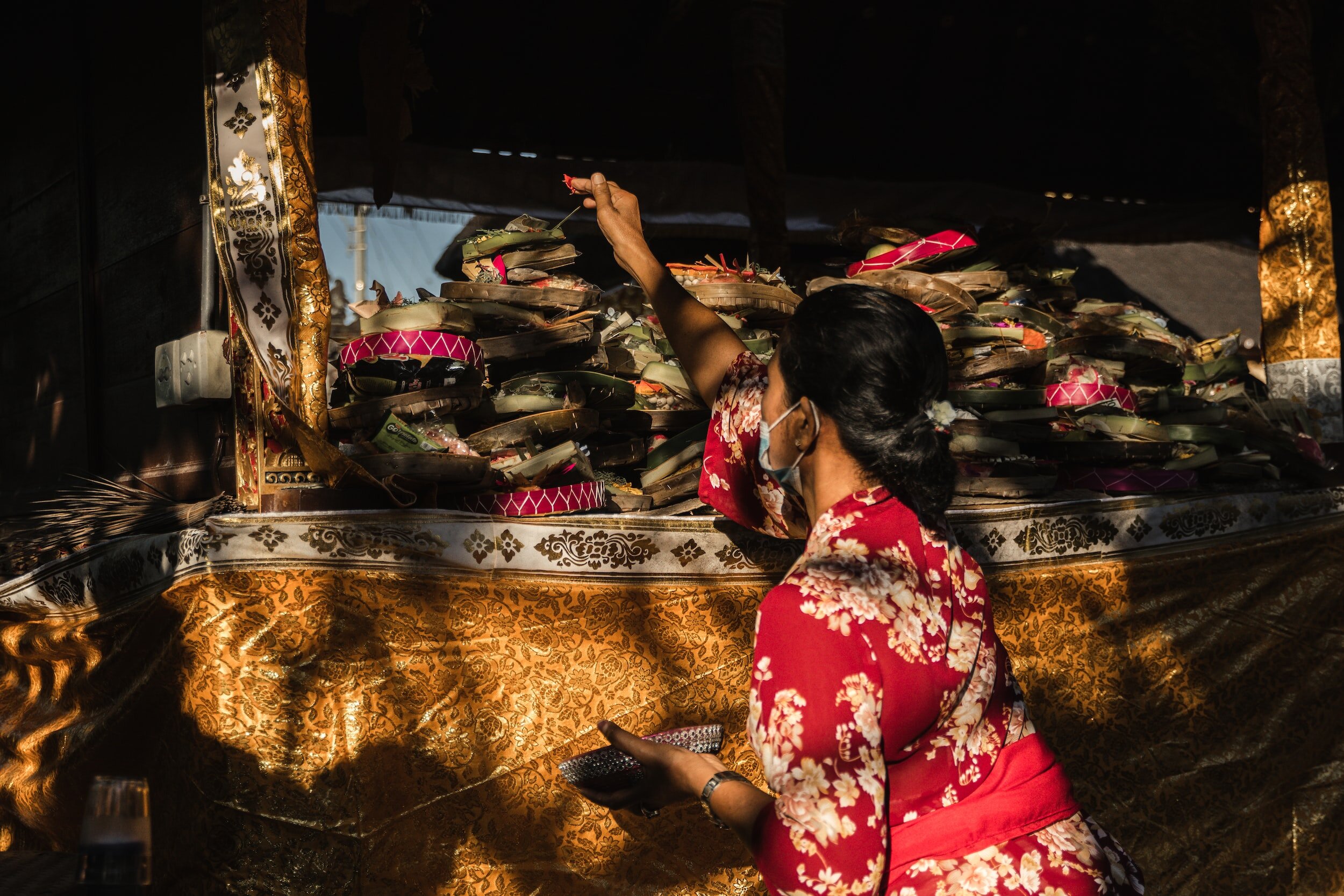Household Shrines: Exploring the Spiritual World of Balinese Homes
Table of Contents Show
Balinese Household Shrines
Balinese religion and culture is infused with spirituality, and one of the most captivating aspects of this unique heritage is the presence of household shrines. These sacred spaces, known as palinggih, are found in every house compound across the island, serving as a focal point for daily devotions and offerings.
In this comprehensive guide, we will delve into the fascinating world of Balinese household shrines, uncovering their significance, the rituals associated with them, and the deep-rooted beliefs that underpin their existence.
The Meaning and Purpose of Household Shrines
In Balinese Hinduism and culture, household shrines are not merely decorative objects; they are imbued with spiritual significance. The Balinese people believe that these shrines are the dwelling places of sacred spirits, be they ancestors or Hindu deities. Ancestors hold a particularly important place in Balinese society, revered as spirits who protect and assist their families in times of need. Their powers can bring prosperity, happiness, and peace, but neglecting their shrines and failing to honor them with regular offerings may lead to misfortune and calamity.
It is interesting to note that the Balinese do not place much emphasis on knowing the names of their ancestors. Instead, they use nicknames or birth order names to refer to one another, indicating a deep-rooted cultural practice that places greater importance on the respect and treatment given to the ancestors rather than their specific identities.
The deified ancestors are collectively known as Nenek Moyong, Dewa Hyang, Pitara Hyang, or Bhatara Hyang, reflecting the Balinese belief in the unity of these ancestral spirits.
The Various Types of Shrines
A typical Balinese family house compound contains several obligatory shrines, each serving a specific purpose and dedicated to different entities. Let's explore some of the most significant shrines found in these compounds:
1. Family Temple (Sanggah)
At the heart of every house compound is the family temple, known as the sanggah. This shrine holds a central place in Balinese religious practices, as it is dedicated to the deified ancestors of the family. While the gods may also be represented in the temple, the primary focus is on the ancestral spirits. The size and complexity of the family temple may vary, depending on the caste and financial means of the family. Regardless of its scale, the family temple is meticulously maintained, and offerings are placed in the shrines regularly, often on a daily basis.
2. Kemulan
One of the essential shrines within the family temple is the kemulan or kemulan taksu. This roofed shrine consists of three side-by-side compartments and is believed to represent the Hindu triad of Brahma, Wisnu, and Siwa. Alternatively, some interpretations suggest that the center section is dedicated to Bhatara Guru, an epithet for Sanghyang Widhi, with the left and right compartments representing male and female characteristics, respectively. The kemulan serves as a shrine for the deified ancestors, symbolizing their presence within the family compound.
3. Sanggah Pengijeng
Another significant shrine found in Balinese house compounds is the sanggah pengijeng. Positioned more or less in the middle of the compound, this roofed shrine with a single compartment acts as a guardian or caretaker of the property. It is believed to be dedicated to Bhatara Surya, the sun, or associated with the four spiritual siblings of every Balinese, known as the kanda empat. The sanggah pengijeng serves as a place of reverence for the family or the niskala family, representing the spiritual realm.
4. Palinggih Taksu
The palinggih taksu is an obligatory shrine that holds a special place in Balinese religious practices. It is dedicated to the taksu, the god of one's profession or talent. According to Balinese beliefs, every individual is born with a unique talent or guna, and this shrine houses the specific taksu associated with that talent. The palinggih taksu is often a roofed shrine with a single compartment, located on the kaja side of the family temple, exemplifying the importance of one's personal talents in Balinese society.
5. Tugu or Penunggun Karang
A distinctive shrine found in many Balinese house compounds is the tugu or penunggun karang. These shrines are low, roofless structures located in the kaja-kauh corner of the property. They are dedicated to Bhatara Kala, a deity often associated with both demons and protection. The tugu shrine serves as a spiritual guardian for the property, providing peace and warding off negative energies. The Balinese believe that any object with an unusual shape or size may house a spirit, and nearby tugu shrines are erected to appease these spirits and ensure harmony.
6. Apit Lawang
One cannot overlook the shrine found at the main entrance gate of a Balinese house compound, known as the apit lawang. This shrine, dedicated to welcoming those with good intentions and deterring those with ill intentions, acts as a guardian to the entrance. Typically, the apit lawang shrine features niches on each side to hold offerings. Its presence signifies the Balinese belief in the spiritual realm's influence on the physical world, with the shrine serving as a conduit between the two realms.
7. Sanggah Paon and Sanggah Sukan
Within the house compound, two inconspicuous shrines play an essential role. The sanggah paon, located in the kitchen, is dedicated to Bhatara Brahma, the god associated with fire. Meanwhile, the sanggah sukan, positioned near the well, is dedicated to Bhatara Wisnu, the god of water. These small shrines are often discreetly placed on the kitchen wall or attached to a nearby tree. Although less prominent, they hold significant symbolic value, representing the vital elements of fire and water within the household.
8. Padmasana
While not an obligatory shrine in every family temple, the padmasana holds immense spiritual significance. It is a class of shrines, all referred to as padma, symbolizing the lotus leaf, traditionally considered the seat of God. The padmasana is divided into three sections, representing the three worlds: bhur (the world of demons), buwah (the world of man), and swah (the world of gods). This elaborate shrine, often located in the kaja-kangin corner of the temple, features intricate carvings and serves as a place of reverence for various manifestations of God.
9. Meru
The meru shrine, characterized by its tiered structure, is not commonly found in ordinary family temples due to its substantial cost and maintenance requirements. However, larger pamerajan temples and many public temples boast this grand shrine. The meru symbolizes Gunung Maha Meru, the world mountain, and can have one to eleven tiers, known as tumpang. Each tier diminishes in size towards the top, resembling a Chinese pagoda. The meru is meticulously constructed according to traditional architectural guidelines and holds deep ceremonial significance.
10. Temporary Shrines
Beyond the permanent shrines, Balinese culture also embraces the creation of temporary shrines for specific purposes. These shrines may be erected for various occasions, such as funerals, caru (animal sacrifice) ceremonies, or larger religious events. Temporary shrines are often simple and easy to assemble, such as the sanggah cucuk, which consists of a bamboo stalk split into four to support a woven base. Other temporary shrines, like the sanggah panggungan and sanggar agung, vary in size and are used during ceremonies held within the family compound.
Rituals and Offerings at Household Shrines
Household shrines come to life through the rituals and offerings performed by Balinese families. These practices are deeply ingrained in everyday life and are considered essential for maintaining spiritual harmony and receiving blessings from the ancestral spirits or deities. Let's explore some of the key rituals and offerings associated with household shrines:
1. Daily Offerings
Every day, after preparing a meal, the housewife or designated family member prepares small offerings called banten jotan. These offerings typically consist of a triangular container made from coconut leaves, filled with bits of rice and other prescribed materials. The family member dons a sash and carries the offerings on a tray, adorned with a stick of burning incense. They proceed to make the rounds of the shrines, placing one offering in each and wafting its essence towards the shrine. This daily ritual ensures the continuous flow of positive energy and blessings within the household.
2. Special Ritual Days
In addition to daily offerings, Balinese families observe various special ritual days throughout the year. Kajeng Keliwon, Tilem, Purnama, and the Tumpek days are just a few examples of these significant dates. On these occasions, larger and more elaborate offerings are prepared and placed in the shrines. These offerings often include flowers, fruits, cakes, and other traditional delicacies. The Balinese believe that these special offerings strengthen their connection with the ancestral spirits and deities, inviting their blessings and protection.
3. Moving Shrines
When a shrine needs to be relocated within the compound or to another locality, a special transfer ceremony takes place. The spirit of the shrine is first transferred to a daksina, a unique offering that is then placed in a temporary shrine nearby. Afterward, the original shrine is completely destroyed, and none of its components can be reused. The materials are often discarded into the sea to ensure they are not inadvertently used again. This ritualistic process reflects the Balinese reverence for the sanctity of the shrines and their belief in the spiritual presence within them.
4. Melaspas Ceremony
Before a permanent shrine can be used, it must undergo a purification ceremony called melaspas. This elaborate ceremony involves placing special offerings, known as padasaran, under the foundation of the shrine. The offerings, often in the form of bricks wrapped in white cloth, are accompanied by numerous other offerings. Additionally, padagingan offerings are placed inside the structure itself, requiring a hole to be dug or chipped into the shrine. The ceremony is considered costly and is not taken lightly, highlighting the importance placed on the sanctity and proper dedication of the shrines.
Cultural Significance and Reverence for Balinese Household Shrines
Each home shrine is regarded with respect and upheld by the family and the local priest.
The existence of household shrines in Balinese culture is a testament to the deep-rooted spirituality and reverence for ancestral spirits and deities. These sacred spaces serve as a constant reminder of the interconnectedness between the physical and spiritual realms, guiding Balinese families in their daily lives. The rituals and offerings performed at the shrines reinforce the sense of spiritual harmony and create a strong bond between the living and the divine.
Balinese household shrines are not merely religious artifacts; they are a tangible expression of the Balinese people's unwavering faith and commitment to their ancestral traditions. These shrines encapsulate the rich cultural heritage of Bali, inviting visitors to immerse themselves in the island's spiritual tapestry and witness the profound devotion that permeates every aspect of Balinese life.
As you explore the enchanting island of Bali, take a moment to appreciate the intricate beauty and spiritual significance of the household shrines that grace every house compound. These shrines are not just architectural marvels but gateways to the spiritual realm, offering a glimpse into the timeless traditions and beliefs that continue to shape the Balinese way of life.
Fascinated? You might also like to read about: The Balinese Calendar and how it guides everyday life in Bali and Blood Sacrifice in Balinese Religion: Understanding the Rituals and Beliefs
Frequently asked questions about Balinese household shrines and temples
What are household temples and shrines in Balinese religion?
Household temples and shrines are small, sacred spaces within Balinese homes that are dedicated to the deities and ancestors. They are an important part of Balinese religious practice and are used for daily offerings and prayers.
What is the significance of household temples and shrines in Balinese religion?
Household temples and shrines are seen as a way to maintain a connection with the divine and to seek the blessings and protection of the deities and ancestors. They are also a way to honor and respect the spiritual heritage of the family.
What are some of the common features of household temples and shrines in Bali?
Common features of household temples and shrines in Bali include statues of deities and ancestors, offerings of food and flowers, and incense burners. They may also include other sacred objects, such as holy water or sacred texts.
How are household temples and shrines maintained in Bali?
Household temples and shrines are typically maintained by the head of the household or a designated family member. They are responsible for making daily offerings and keeping the space clean and well-maintained.
How do household temples and shrines reflect the Balinese belief in the importance of family and community?
Household temples and shrines reflect the Balinese belief in the importance of family and community by emphasizing the idea that spirituality is a shared experience. They are a way to connect with the deities and ancestors as a family unit and to maintain a sense of community and togetherness.
Are there any specific rules or customs associated with the placement of household temples and shrines in Bali?
Yes, there are specific rules and customs associated with the placement of household temples and shrines in Bali. They are typically located in the northeast corner of the home, which is considered the most auspicious direction. Additionally, they should be kept clean and free from clutter.
How do household temples and shrines contribute to the overall spiritual well-being of the family?
Household temples and shrines are believed to contribute to the overall spiritual well-being of the family by providing a space for daily offerings and prayers. They are a way to maintain a connection with the divine and to seek the blessings and protection of the deities and ancestors. They also serve as a reminder of the sacredness of everyday life and help to maintain spiritual balance and harmony within the family.
How do household temples and shrines reflect the Balinese belief in the importance of hospitality?
Household temples and shrines reflect the Balinese belief in the importance of hospitality by emphasizing the idea that the deities and ancestors should be welcomed and honored as guests in the home. They are a way to show respect and gratitude for the blessings received and to maintain a sense of hospitality and generosity.
How do household temples and shrines reflect the Balinese belief in the interconnectedness of all things?
Household temples and shrines reflect the Balinese belief in the interconnectedness of all things by emphasizing the idea that the deities and ancestors are present in all aspects of life, including the home. They are a way to maintain a connection with the divine and to honor the spiritual heritage of the family.
How do household temples and shrines contribute to the preservation of Balinese cultural heritage?
Household temples and shrines are an integral part of Balinese cultural heritage and are passed down through generations. The traditional practices and rituals associated with household temples and shrines help to preserve and promote Balinese culture. They serve as a way to maintain and celebrate the unique customs and traditions of Bali.






















Bali's remarkable rice terraces draw numerous tourists. However, could tourism pose a threat that the age-old Subak system might struggle to overcome?